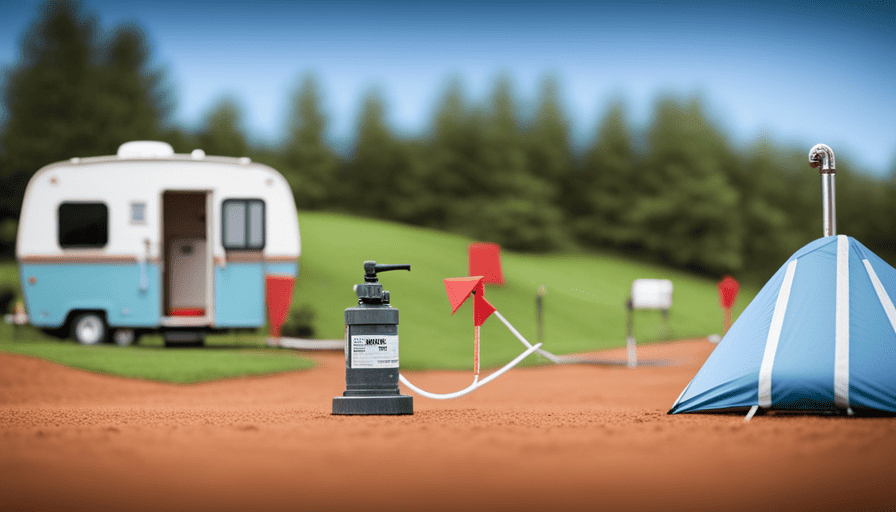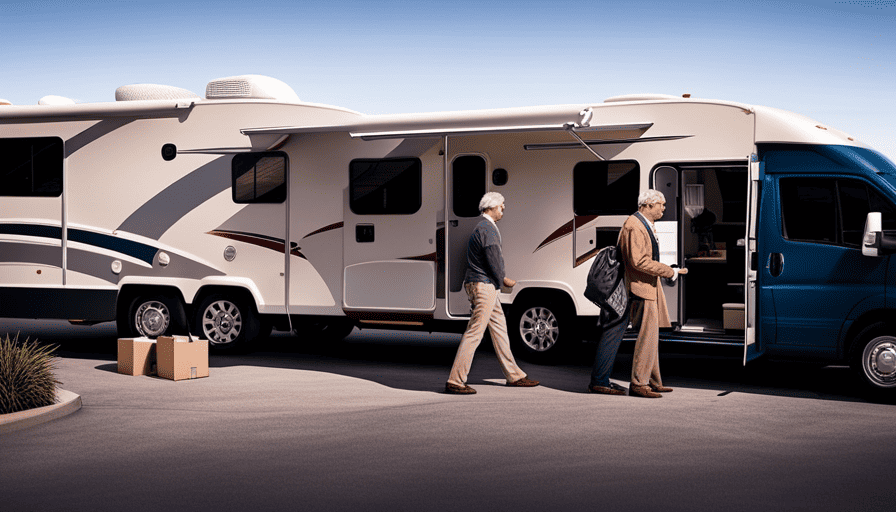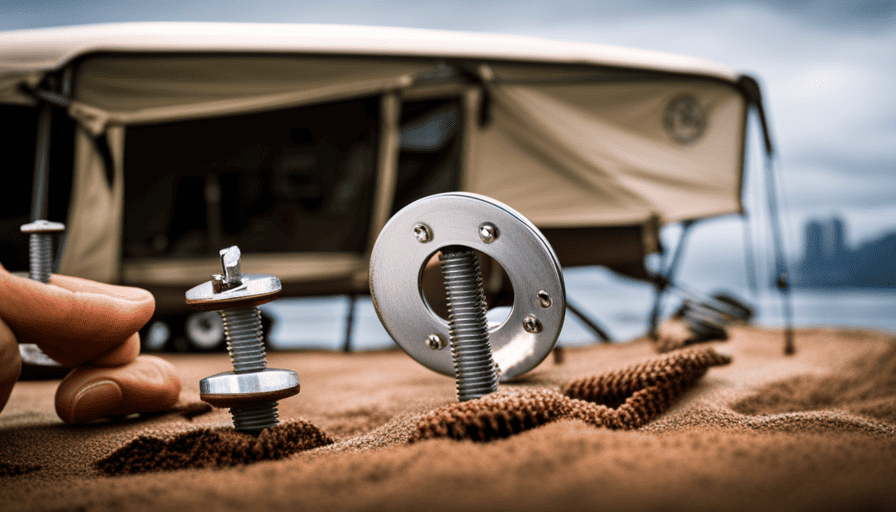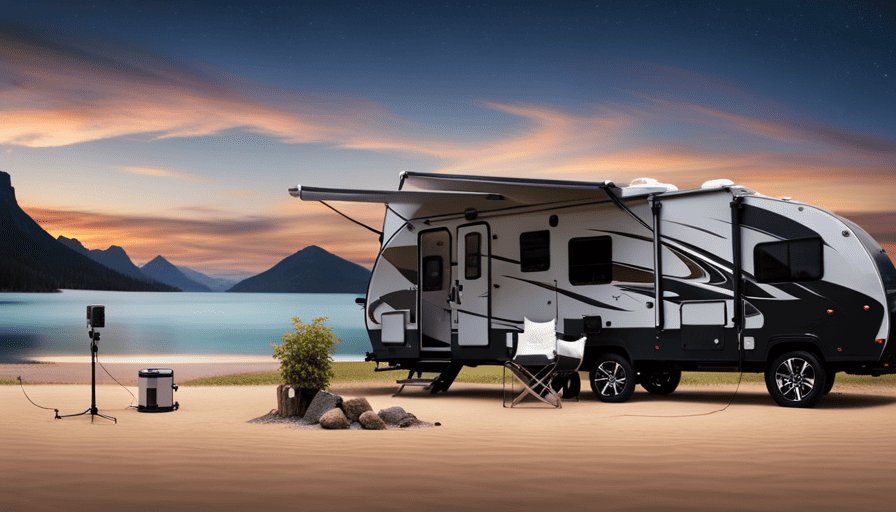So, you’ve made the leap to embrace nomadic living in your reliable camper. However, as seasoned wanderers are well aware, there’s a critical detail that demands attention – connecting to a septic system. Ah, the delightful realm of managing waste. Worry not, my fellow explorers, as I stand ready to navigate you through the detailed journey of linking your camper with a septic tank.
In this informative article, I will provide you with step-by-step instructions on how to:
- Navigate the local regulations and permits
- Gather the necessary equipment
- Locate and prepare the septic tank connection point
- Connect your camper’s sewage outlet to the septic tank
We will also delve into:
- The installation of a piping system for waste disposal
- Creating a secure and sanitary connection point
- Practicing proper waste management and disposal
- Regular maintenance and cleaning of your connection
So grab your wrenches and put on your gloves, because we are about to embark on a journey into the world of camper-to-septic-tank hookups. Let’s get started!
Key Takeaways
- Understand local regulations and obtain necessary permits before hooking up your camper to a septic tank.
- Gather the necessary equipment and tools, including a sewer hose designed for RV use, a sewer hose support, and a sewer hose rinse kit for cleaning.
- Locate and prepare the septic tank connection point by using a metal detector or hiring a professional to find the tank and digging a trench for proper drainage.
- Ensure a secure and tight seal between the camper’s sewage outlet and the septic tank to prevent leaks, and regularly maintain and clean the connection for optimal functionality.
Understand Local Regulations and Permits
Before you start hooking up your camper to a septic tank, it’s crucial to understand the local regulations and permits.
Understanding the legal requirements and obtaining necessary permits is essential to ensure that you are in compliance with the law and that you protect the environment.
Firstly, it’s important to research and familiarize yourself with the specific regulations governing the use of septic systems in your area. Some locations may have restrictions on the size and type of septic tanks that can be used, as well as guidelines on where they can be placed on your property. Additionally, there may be rules regarding the disposal of waste from recreational vehicles into the septic system.
Next, you will need to obtain the necessary permits. This typically involves filling out an application and providing information about your septic system and its intended use. Depending on your location, you may also need to pay a fee and undergo an inspection to ensure that your septic system meets the required standards.
Once you have a clear understanding of the legal requirements and have obtained the necessary permits, you can move on to the next step of the process, which is gathering the necessary equipment and tools.
Gather the Necessary Equipment and Tools
To properly connect the camper to the septic system, it’s crucial to gather all the essential gear and tools. Equipment selection is an important aspect of this process.
First and foremost, you’ll need a sewer hose that’s specifically designed for RV use. Look for a hose that’s durable, leak-proof, and has the appropriate length for your setup.
Additionally, you’ll need a sewer hose support, which helps to keep the hose elevated and prevent any clogs or leaks. Safety precautions must also be taken into consideration. It’s vital to wear gloves and protective eyewear while handling the sewer hose to avoid any contact with waste materials.
Furthermore, you may want to invest in a sewer hose rinse kit, which allows you to clean the hose thoroughly after each use. This not only ensures hygiene but also prolongs the life of the hose.
By gathering the necessary equipment and taking appropriate safety measures, you can ensure a smooth and hassle-free connection between your camper and the septic system. Now, let’s move on to the next step of this process: locating and preparing the septic tank connection point.
Locate and Prepare the Septic Tank Connection Point
Once you’ve gathered all the necessary equipment, it’s time to find and prepare the connection point for the camper’s septic system.
Locating the septic tank is the first step in this process. It may be buried underground, so you will need to use a metal detector or hire a professional to locate it accurately. Once you have found the septic tank, mark the location using a stake or flag for easy reference.
After locating the septic tank, it’s important to prepare the connection point. Start by digging a trench from the camper’s sewage outlet to the septic tank. Make sure the trench is deep enough to accommodate the pipes and provide proper drainage.
Next, remove any debris or obstructions from the connection point to ensure a secure and efficient connection.
To prepare the septic tank connection, you will need to clean the pipe opening. Use a pipe cleaner or wire brush to remove any dirt, grime, or buildup. This will ensure a tight seal and prevent any leaks or odors.
Once the connection point is located and prepared, you’re ready to connect the camper’s sewage outlet to the septic tank. This will allow for the proper disposal of waste and ensure a hygienic camping experience.
Connect the Camper’s Sewage Outlet to the Septic Tank
Now it’s time for me to make the vital connection from my camper’s sewage outlet to the underground septic system. This step is crucial for proper sewage disposal and septic tank maintenance.
To begin, I’ll locate the septic tank access point near my camper. Once located, I’ll remove the cover from the access point and ensure that the tank is empty before proceeding.
Next, I’ll attach a sewer hose to the camper’s sewage outlet. This hose should be long enough to reach the septic tank access point. I’ll securely connect one end of the hose to the outlet, ensuring a tight seal to prevent any leaks or spills.
With the hose connected, I’ll carefully guide the other end into the septic tank access point. It’s important to be cautious during this step to avoid any damage to the hose or the septic system. Once the hose is inserted, I’ll make sure it’s securely in place to prevent any disconnections or leaks.
Once the connection is made, I can proceed to the subsequent section about installing a piping system for waste disposal. This will further enhance the efficiency of my sewage disposal process and ensure the proper maintenance of my septic tank.
Install a Piping System for Waste Disposal
Installing a piping system for waste disposal enhances the efficiency of sewage disposal and ensures proper maintenance of the septic system. When setting up a camper to a septic tank, it is crucial to install a well-designed and properly functioning piping system. Here are some tips to consider when installing a piping system for waste disposal in order to ensure a seamless connection with the septic tank and maintain its functionality:
| Tips for Piping System Installation | Septic Tank Maintenance Guidelines |
|---|---|
| Use PVC pipes for durability and longevity. | Regularly pump the septic tank to prevent overflow. |
| Ensure the pipes have the correct slope for proper flow. | Avoid flushing non-biodegradable items down the toilet. |
| Install a cleanout valve for easy access and maintenance. | Use septic-safe toilet paper to prevent clogs. |
| Seal all connections securely to prevent leaks. | Avoid excessive water usage to prevent overloading the septic system. |
By following these piping system installation tips and septic tank maintenance guidelines, you can ensure a reliable connection between your camper and the septic tank. This will help maintain the functionality of the septic system and prevent any potential issues. After installing the piping system, it is important to test the connection for leaks and proper functioning, which will be discussed in the subsequent section.
Test the Connection for Leaks and Proper Functioning
To ensure the reliability of the piping system, it’s essential to thoroughly test the connection for any leaks or malfunctions. Testing the connection not only helps identify potential issues but also ensures that the camper is securely connected to the septic tank. Here are some testing methods and troubleshooting tips to help you with this process:
-
Visual Inspection: Start by visually inspecting the connection points for any visible leaks or loose fittings. Check the seals and gaskets for any signs of wear or damage.
-
Water Pressure Test: Connect a water hose to the camper’s waste disposal system and turn on the water. Monitor the connection points for any leaks or water seepage. If you notice any leaks, tighten the fittings or replace the defective parts.
-
Smoke Test: Another method to check for leaks is by using a smoke test. Insert a smoke bomb or smoke pellets into the camper’s waste system and observe if any smoke escapes from the connection points. If smoke is detected, it indicates a leak.
-
Dye Test: Add a colored dye to the camper’s waste system, then flush water through the pipes. Check the septic tank and the connection points for any traces of the dye. If the dye is present, it suggests a leak.
By following these testing methods and troubleshooting tips, you can ensure a secure and sanitary connection point between your camper and the septic tank.
Create a Secure and Sanitary Connection Point
Creating a secure and sanitary connection point ensures a reliable and leak-free system for waste disposal in your recreational vehicle. When hooking up your camper to a septic tank, it’s crucial to maintain a durable connection to prevent contamination risks and ensure the proper functioning of your waste management system.
To create a secure connection point, start by using a high-quality, airtight sewer hose that’s specifically designed for RV use. This hose should have a secure fitting on one end to attach to the septic tank and a bayonet fitting on the other end to connect to your camper’s waste outlet. Make sure all connections are tightly secured to prevent any leaks.
Next, it’s important to ensure a sanitary connection. Before connecting the sewer hose, wear disposable gloves to protect yourself from any potential contaminants. Additionally, it’s recommended to use a sewer hose support to keep the hose off the ground and prevent any damage or contamination.
By creating a secure and sanitary connection point, you can prevent contamination risks and maintain a reliable waste disposal system in your camper. Now, let’s transition into the next section about practicing proper waste management and disposal, which is essential for maintaining a clean and healthy environment during your travels.
Practice Proper Waste Management and Disposal
Take a moment to reflect on the importance of maintaining a clean and responsible waste disposal system, ensuring a pristine and unspoiled environment for all your future adventures. Proper waste management practices are crucial when hooking up your camper to a septic tank. Not only do these practices ensure a sanitary connection, but they also minimize the environmental impact of your waste. Conducting an environmental impact assessment before setting up your camper can help identify potential risks and implement necessary precautions.
To effectively manage waste, it is essential to separate solid waste from liquids. Utilizing a 2 column and 4 row table, you can organize different waste types and their appropriate disposal methods:
| Waste Type | Disposal Method |
|---|---|
| Solid Waste | Bag and dispose in designated trash bins |
| Toilet Waste | Connect directly to the septic tank |
| Graywater Waste | Use a separate hose to drain into a designated area |
| Chemical Waste | Dispose of at authorized facilities |
Remember to regularly maintain and clean the connection between your camper and the septic tank to prevent clogs and ensure optimal functionality.
Regularly Maintain and Clean the Connection
Regularly maintaining and cleaning the connection between your recreational vehicle and the waste disposal system is vital for ensuring its optimal functionality and preventing any potential issues. To keep your camper hooked up to the septic tank running smoothly, it’s important to perform regular maintenance on the connection.
One of the first steps in this process is to visually inspect the connection for any signs of wear or damage. Look for cracks or leaks in the hoses, fittings, and seals. If any issues are found, they should be addressed immediately to prevent further damage.
Cleaning the connection is also an essential part of regular maintenance. Start by flushing out the waste lines with clean water to remove any debris or buildup. Use a specialized RV sewer hose rinser to thoroughly clean the hose and ensure the flow of waste is unobstructed. Additionally, it’s recommended to use RV-specific cleaning solutions to sanitize and deodorize the waste system.
Remember, regular maintenance and cleaning techniques are necessary to keep the connection between your camper and septic tank in optimal condition. By taking the time to inspect and clean the connection regularly, you can prevent potential problems and maintain a reliable waste disposal system. However, if you encounter any difficulties or are unsure about how to perform these tasks, it’s always best to seek professional assistance. This will ensure that the job is done correctly and safely.
Seek Professional Assistance if Needed
If you’re ever unsure about how to properly maintain and clean your RV’s waste disposal system, it’s always wise to seek professional assistance to ensure the job is done correctly and safely.
The intricate nature of hooking up a camper to a septic tank requires specialized knowledge and expertise that professionals possess. They can guide you through the process, ensuring that all connections are secure and that no leaks or blockages occur.
When seeking professional assistance, there are a few things to keep in mind. First, make sure to hire a licensed and experienced technician who’s familiar with RV waste disposal systems. They should be knowledgeable about local regulations and requirements regarding the installation and maintenance of septic tanks. This will help ensure that your setup complies with all necessary guidelines.
Additionally, when consulting with a professional, it’s essential to discuss any specific concerns or questions you may have. They can provide valuable insights and advice tailored to your situation. Whether it’s troubleshooting a problem, understanding the best cleaning methods, or complying with local regulations, their expertise will prove invaluable.
Seeking professional assistance when hooking up your camper to a septic tank is crucial. They possess the necessary knowledge and experience to ensure a safe and efficient setup. By following local regulations and consulting with a professional, you can be confident that your waste disposal system is properly maintained and compliant.
Frequently Asked Questions
How do I determine the specific regulations and permits required for connecting a camper to a septic tank in my local area?
To determine the specific regulations and permits required for connecting a camper to a septic tank in your local area, you need to consult your local health department or building permit office. They can provide you with the necessary information and guidelines to ensure compliance with the applicable regulations.
It’s important to obtain the required permits to ensure the proper installation and connection of your camper to the septic tank, ensuring the safety and efficiency of the system.
What are the necessary equipment and tools needed to successfully hook up a camper to a septic tank?
To successfully hook up a camper to a septic tank, you’ll need the following equipment and tools:
- A sewage hose
- An adjustable wrench
- Teflon tape
- Rubber gloves
- A sewer adapter
Before starting, make sure you’ve obtained the necessary permits and complied with local regulations.
Here’s how to do it:
- Locate the connection point on your camper and the sewage outlet on the septic tank.nn2. Connect the two using a piping system, making sure to secure the connection properly.nn3. Always follow sanitary standards during waste disposal.
Remember to always follow sanitary standards when dealing with waste disposal.
How do I locate and prepare the exact connection point on my septic tank for the camper’s sewage outlet?
To locate and prepare the exact connection point on your septic tank for the camper’s sewage outlet, you need to determine the septic tank dimensions. This can be done by referring to the original blueprints or contacting a professional septic tank service.
Once you have the dimensions, you can troubleshoot common septic tank connection issues such as blockages or leaks. It’s crucial to ensure a proper and secure connection to prevent any potential sewage leaks or contamination.
Are there any specific guidelines or considerations for installing a piping system for waste disposal from the camper to the septic tank?
When it comes to installing a piping system for waste disposal from your camper to the septic tank, there are several important guidelines to consider.
First, ensure that the pipes are made of durable and corrosion-resistant materials to prevent leaks and damage. Additionally, make sure the pipes are properly sized and sloped to facilitate smooth flow and prevent clogging.
It is also crucial to install a proper venting system to prevent odors and gases from accumulating.
Following these guidelines will ensure a successful and efficient waste disposal system for your camper.
How can I ensure that the connection between the camper and the septic tank is secure, sanitary, and meets all necessary standards?
To ensure a sanitary connection between your camper and the septic tank, it’s crucial to follow septic tank regulations. One interesting statistic is that a faulty connection can lead to contamination of groundwater, causing potential health hazards.
To meet necessary standards, use a properly sized, leak-proof hose and secure it tightly to the septic tank outlet. Additionally, install a p-trap or a backflow prevention device to prevent any waste from flowing back into the camper.
Conclusion
Well, there you have it, folks! You’re now fully equipped with the knowledge and skills to hook up your camper to a septic tank. Who would’ve thought that connecting your sewage outlet to a septic tank could be so thrilling? But hey, we’re living on the wild side here!
Remember to follow all local regulations and permits, gather the necessary equipment, and create a secure and sanitary connection point. And don’t forget, proper waste management is key!
So go forth, my adventurous friends, and conquer that septic tank hookup like the waste disposal warriors you are!










